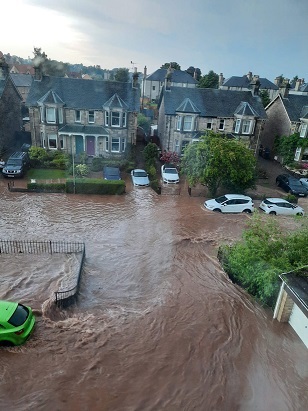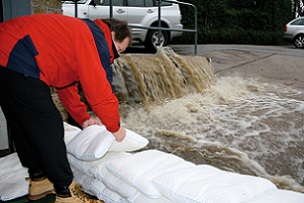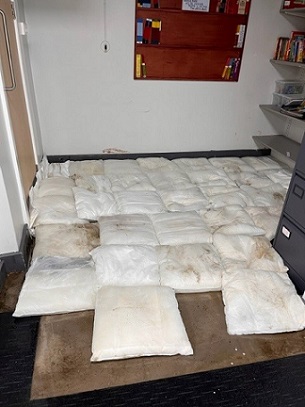 Flooding can cause countless thousands of pounds damage and force you out of your home or business for months
Flooding can cause countless thousands of pounds damage and force you out of your home or business for months
 Traditional sandbags quickly rot and the spilled sand harms the environment, clogging up drains
Traditional sandbags quickly rot and the spilled sand harms the environment, clogging up drains
 FloodSax alternative sandbags keeping a torrent of floodwater at bay
FloodSax alternative sandbags keeping a torrent of floodwater at bay
 FloodSax can be used indoors to soak up water which they did here at this Yorkshire school
FloodSax can be used indoors to soak up water which they did here at this Yorkshire school
Here’s how to get vital information on risk of flooding and advice on how to prevent flooding
Millions of people in the UK have no idea where to get information about the risk of flooding or what to do to prevent it.
And with almost 2 million people living in areas at significant risk of flooding, one in seven householders don’t even have buildings or content insurance.
The statistics have been revealed by The British Red Cross which is often called out to deal with the aftermath of natural disasters such as flooding.
Quick answers to the questions where to get information about the risk of flooding or what to do to prevent it are that sandbags are now seen as an ineffective and environmentally disastrous way to try to stop flooding as the bags deteriorate and the sand gets washed down drains, clogging them up and causing more flooding.
Many local councils now prefer FloodSax sandless sandbags devised and made by Yorkshire company Environmental Defence Systems Ltd.
Advice on all kinds of anti-flood devices is available on a special Blue Pages website run by the charity the National Flood Forum and to access it simply click here http://bluepages.org.uk/
Many people don’t realise that councils have no responsibility to provide sandbags or any other flood prevention measures if flooding is imminent. People have to protect their own property which is why so many turn to FloodSax (http://www.floodsax.co.uk/) as they are incredibly space-saving to store and quick and easy to deploy.
To check the flood risk in your area simply go to https://www.gov.uk/check-flooding
The British Red Cross has released its report called Every Time It Rains to coincide with a warning that flooding is forecast for the early part of 2023.
The report includes insight from focus groups in Rhondda Cynon Taf, Hull, Belfast and Glasgow, which have the highest flood risk under climate change. People from Rhondda Cynon Taf and Hull had previously experienced serious flooding.
Polling accompanying the report shows:
- Four in five people (81%) don’t know where to get information on floods.
- Three in four people (73%) don’t have good understanding of their area’s flood risk.
- One in seven (15%) don’t have buildings or contents insurance. Half of those without insurance say this is due to cost of living or other financial pressures.
- Two in three people (66%) in the UK think we are currently seeing more flooding in the UK as a result of climate change. More than three in four (77%) think it’s likely that climate change will result in more flooding in the UK.
Chris Davies, Head of Emergency Planning and Response at the British Red Cross said: “Floods are one of the most serious climate-related hazards we face in this country. They can devastate homes, destroy irreplaceable and sentimental items, cost families thousands of pounds of damage and cause immense suffering.
“This research shows that while most people recognise climate change is increasing the risk of floods, they don’t know how to prepare or get information. Millions of people across the country are vulnerable but only one in seven have taken steps to protect their homes.
“We’re calling on national and local governments to work with communities to better prepare the public for flooding. We need clearer information on what to do before, during and after a flood and we need to ensure communities fully understand the risk they face.”
The British Red Cross is calling for changes to increase the UK’s resilience to floods, including:
- Better use of future flood risk maps and data to help communities understand their risk and take action.
- Prioritised support for those communities and individuals who are particularly vulnerable.
- Flooding information that is tailored to the needs of specific communities.
- Support for people to get the right insurance against flooding.
- Clarity on what actions individuals and businesses should take to prepare for flooding.
- Improved engagement between local authorities and affected communities to support local action and build resilience.
- A coordinated and comprehensive national approach and guidance to prepare and respond to emergencies, including floods.
The British Red Cross is urging people to
- Download the British Red Cross App https://www.redcross.org.uk/get-help/prepare-for-emergencies/free-emergency-apps and set emergency alerts for your area.
- Check the Met Office website https://www.metoffice.gov.uk/ for weather and flood warnings.
- Prepare an emergency kit in case you need to leave quickly
- Check your insurance policy and that you’re covered for flooding. Be aware that excesses are usually way higher for both external and internal floods than your usual insurance excess so it’s always worth spending a few pounds in advance being prepared with FloodSax alternative sandbags to keep the water out.